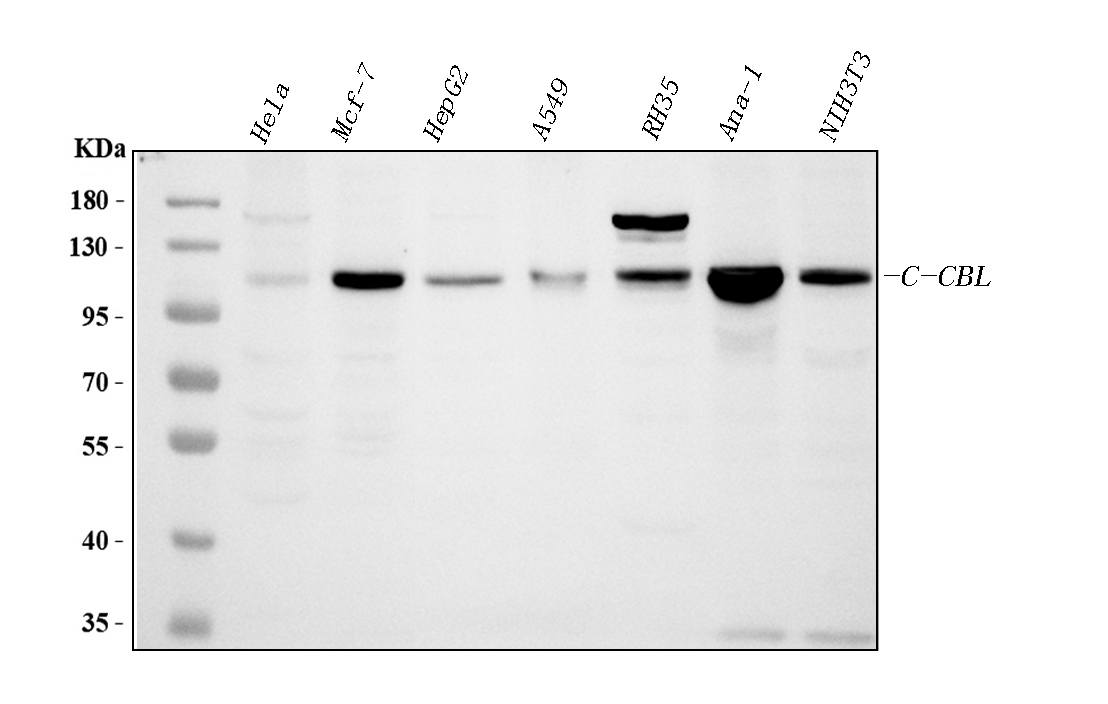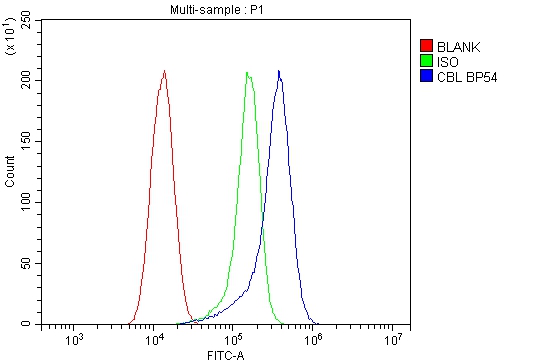| Western blot (WB): | 1:500-2000 |
| Immunohistochemistry (IHC): | 1:50-400 |
| Immunocytochemistry/Immunofluorescence (ICC/IF) | 1:50-400 |
| Flow Cytometry (Fixed): | 1:50-200 |
| (Boiling the paraffin sections in 10mM citrate buffer,pH6.0,or PH8.0 EDTA repair liquid for 20 mins is required for the staining of formalin/paraffin sections.) Optimal working dilutions must be determined by end user. | |

Western blot analysis of c-Cbl/CBL using anti-c-Cbl/CBL antibody (PB0022). The sample well of each lane was loaded with 30 ug of sample under reducing conditions.
Lane 1: Hela whole cell lysates,
Lane 2: Mcf-7 whole cell lysates,
Lane 3: HepG2 whole cell lysates,
Lane 4: A549 whole cell lysates,
Lane 5: RH35 whole cell lysates,
Lane 6: Ana-1 whole cell lysates,
Lane 7: NIH/3T3 whole cell lysates.
After electrophoresis, proteins were transferred to a membrane. Then the membrane was incubated with rabbit anti-c-Cbl/CBL antigen affinity purified polyclonal antibody (PB0022) at a dilution of 1:1000 and probed with a goat anti-rabbit IgG-HRP secondary antibody (Catalog # BA1054). The signal is developed using ECL Plus Western Blotting Substrate (Catalog # AR1197). A specific band was detected for c-Cbl/CBL at approximately 120 kDa. The expected band size for c-Cbl/CBL is at 100 kDa.

Flow Cytometry analysis of A549 cells using anti-c-Cbl/CBL antibody (PB0022).
Overlay histogram showing A549 cells stained with PB0022 (Blue line). To facilitate intracellular staining, cells were fixed with 4% paraformaldehyde and permeabilized with permeabilization buffer. The cells were blocked with 10% normal goat serum. And then incubated with rabbit anti-c-Cbl/CBL Antibody (PB0022) at 1:100 dilution for 30 min at 20°C. Fluoro488 conjugated goat anti-rabbit IgG (BA1127) was used as secondary antibody at 1:100 dilution for 30 minutes at 20°C. Isotype control antibody (Green line) was rabbit IgG at 1:100 dilution used under the same conditions. Unlabelled sample without incubation with primary antibody and secondary antibody (Red line) was used as a blank control.

Western blot analysis of c-Cbl/CBL using anti-c-Cbl/CBL antibody (PB0022). The sample well of each lane was loaded with 30 ug of sample under reducing conditions.
Lane 1: Hela whole cell lysates,
Lane 2: Mcf-7 whole cell lysates,
Lane 3: HepG2 whole cell lysates,
Lane 4: A549 whole cell lysates,
Lane 5: RH35 whole cell lysates,
Lane 6: Ana-1 whole cell lysates,
Lane 7: NIH/3T3 whole cell lysates.
After electrophoresis, proteins were transferred to a membrane. Then the membrane was incubated with rabbit anti-c-Cbl/CBL antigen affinity purified polyclonal antibody (PB0022) at a dilution of 1:1000 and probed with a goat anti-rabbit IgG-HRP secondary antibody (Catalog # BA1054). The signal is developed using ECL Plus Western Blotting Substrate (Catalog # AR1197). A specific band was detected for c-Cbl/CBL at approximately 120 kDa. The expected band size for c-Cbl/CBL is at 100 kDa.

Flow Cytometry analysis of A549 cells using anti-c-Cbl/CBL antibody (PB0022).
Overlay histogram showing A549 cells stained with PB0022 (Blue line). To facilitate intracellular staining, cells were fixed with 4% paraformaldehyde and permeabilized with permeabilization buffer. The cells were blocked with 10% normal goat serum. And then incubated with rabbit anti-c-Cbl/CBL Antibody (PB0022) at 1:100 dilution for 30 min at 20°C. Fluoro488 conjugated goat anti-rabbit IgG (BA1127) was used as secondary antibody at 1:100 dilution for 30 minutes at 20°C. Isotype control antibody (Green line) was rabbit IgG at 1:100 dilution used under the same conditions. Unlabelled sample without incubation with primary antibody and secondary antibody (Red line) was used as a blank control.

